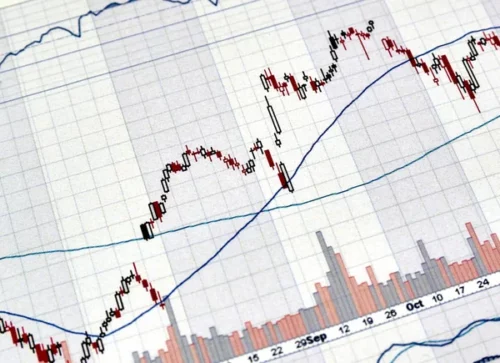It is commonly thought that stock price gaps always get filled up, but is this actually the case? What types of gaps fill up, and can traders create positions to profit from them?
In short, do stock gaps always get filled?
We did a deep dive to understand gap-fill trading, and this article will give you the answers to all such questions.
What is a Gap Fill?
A gap is a large change in the value of a financial instrument with no major buying or selling activity in between.
The term gap fill refers to the eventual return of the asset to its pre-gap price level.
Most gaps typically occur during pre-market or after-hours trading.
Let us understand all of this in detail.
The origin of the term “gap” lies in a sudden deviation in the trading chart of the financial instrument from its normal price patterns.
There are two reasons why it happens.

One could be that a major piece of news related to the security comes out after hours.
Another possibility is that a big change happened in its technical or fundamental indicators.
In the next section, we will cover these in more detail.
Many technical analysts assert that all trading gaps fill. This is based on the often-seen tendency for asset prices to revert to their mean.
We will explore whether this always holds true or not in later sections as well.
Moreover, there is an opportunity to profit from gaps by using them to make future price predictions.
The article will delve into some ways in which this can be done as well.
How a Price Gap is Created
Gaps occur when the fundamental or technical factors of a stock get significantly changed during a period of low trading (such as after market hours).
One reason could be an unexpected news event about an asset.
Let us take the case of security XYZ whose financial results will be declared.
While most analysts predict a tempered growth in revenues and profits, the results are outstanding.
In this case, the opening value of XYZ on the next day might be significantly higher than the previous closing price, creating an “up gap.”
An example of changes in technical parameters could be a stock that breaches its support or resistance band in the last session of the day’s trade.

If this happens, the security might sometimes end up with a gap the next day.
In recent years, automated program trading has made gaps more common.
By placing large, decisive bets in after-market transactions, algorithmic trading can trigger price movements.
This attracts other traders to create positions in the same direction.
All of the pricing pressure builds up and creates a gap.
Types of Price Gaps
Gaps that happen due to technical parameter shifts can be categorized in four ways.
Below, we look at the characteristics of all of them.
Common Gaps
Common gaps are usually small ones that do not happen due to major events and get filled up quickly.
Something as minor as a stock going ex-dividend during a low-volume trading period can create one.
Most do not offer many opportunities for traders to take positions or generate profits.
Breakaway gaps
For a breakaway gap to happen, a stock needs to have been in a particular price range for a significant period of time.
Once market confidence starts to move the security out of the band, a breakaway gap is created.
This event causes a double whammy. It forces fence-sitters on the wrong side of the gap price to close their positions and move out.

This increases trading volume, which drives the price upwards.
It also assures traders who hold positions on the right end of the gap that the security has moved into a new cycle.
The gap then becomes the resistance point for the new trend.
Breakaway gaps typically do not fill out quickly since they mark a deviation from the previous pricing band.
Runaway gap
Runaway gaps occur because of a sudden, enhanced interest in an upward-trending underlying asset.
For example, if there is strong, positive, and continued growth in a security, it might create a runaway gap.
One factor is traders who missed out on the original movement. They would want to get in on the action, causing a volume surge.
Another reason for increased interest could be a positive news event, which creates renewed excitement in an already growing share.
Runaway gaps can also occur in downward-trending stocks.
This happens when the reverse is true – a piece of bad news or a continued downward trend causes a loss of interest from several investors.
Exhaustion Gaps
These types of gaps occur at the far end of a strong positive or negative period in the stock’s price.
Usually, they signal an end to the cycle.
They are like a final gasp of upward or downward movement.
Because both runaway and exhaustion gaps mark the end of a price cycle, they are easily confused.
The key difference between the two is that the latter experiences a significantly high trading volume.
Exhaustion gaps also tend to get filled very quickly due to profit-taking (in an uptrend) or panic selling (in the opposite direction).
Do Stock Gaps Always Get Filled?
Most of the time, there is a tendency for stock prices to revert to the mean and fill the gap. This happens because of several reasons.
Firstly, it could be that the trading gap was created out of either irrational exuberance or pessimism towards the share. If that’s the case, traders and analysts will soon figure out the truth and return to the earlier position.

Another problem is that a sudden price change doesn’t leave support or resistance for the security.
This can cause traders to panic and take positions at the pre-gap level, pushing the price backward.
Lastly, an exhaustion gap always reverts.
This is because it happens at the far end of a value cycle and causes profit-taking or panic selling that pushes the stock back.
Breakaway or continuation gaps are likely not to be filled.
What Percent of Gaps Get Filled in Stocks?
There is statistical data to show that nearly 91.4% of up gaps get filled.
However, there are some caveats to this analysis.
Firstly, the securities selected for the study were all index stocks with an upward trend.
Moreover, the study does not analyze up and down gaps, only the former kind.
But overall, the research indicates that stocks tend to fill the gap eventually in 9 out of 10 cases.
In fact, some gaps even get filled during the same day’s trade.
This usually occurs when the initial euphoria of a big piece of news dies down, and more sober reflection causes traders to revert back to older positions.
Mean reversion is a principle employed by many investors during technical analysis for setting up trades
They create positions assuming that a stock price will return after a gap occurs.
Like any trading strategy, there is a risk factor involved here.
As mentioned earlier, some gaps do not revert back to the original price pattern, and betting against them might cause losses.
Do Price Gaps Help Predict Future Moves?
Yes, price gaps can indicate future pricing trends for an underlying stock.
A gap accompanied by high-volume trades during the after-market hours often indicates a long-term price trend.
This is because such activity shows that institutional investors have set up positions in accordance with the gap.
Such a high volume could indicate that the direction of the gap is likely to continue in the coming weeks and months.
However, smaller gaps are less indicative of such a trend and might indicate an eventual mean reversion instead.
In the next section, we look at more ways in which traders can use gaps to create a trading strategy.
Gap and Fill Trading Strategies
We discuss below four often employed methods by investors who want to trade gaps.

Assuming The Gap
In this technique, traders that foresee the occurrence of a potential gap in the next session use it to set up their positions.
For example, if a negative financial report comes out after the close of the day’s trade, investors might sell off shares in the post-market hours.
This helps them avoid getting into a possible gap the next day.
Low Liquidity Gaps
If an upward gap occurs with low trading volume, it is possible that the trend will continue as more of it comes in later sessions.
In such a situation, the trader might create a buy position to take advantage of the expected price movement.
Fading
When an up gap is formed but hits a resistance point, it is possible that it might fade.
A fade is when a gap gets filled during the same trading day.
This can happen if a positive piece of news is tempered after analysts point out other issues in the underlying security.
Investors might use this knowledge to short the stock since there is a likelihood that it will revert to the starting point of the gap.
By doing so, they create price pressure on the share to revert back to its mean.
Post Fill
When a stock price gap is filled, and it continues going in the same direction, traders can bet on the security to swing back (somewhat like a pendulum).
This strategy assumes that the stock will again come to the point where the gap was created after some time.
Final Thoughts
There is evidence that stock gaps get filled nearly 90% of the time.
This makes them a good predictor for price movements.
Traders can use the tendency of securities to revert back to their means in several ways, which we have covered above.
However, it is important to understand that not all gaps get filled, especially runaway and breakaway ones.
There is nothing that is 100% certain in investing. Hence investors must exercise their judgment while using such trading strategies.


 Tags:
Tags:










